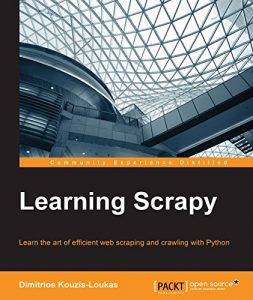Key Features
- Extract data from any source to perform real time analytics.
- Full of techniques and examples to help you crawl websites and extract data within hours.
- A hands-on guide to web scraping and crawling with real-life problems and solutions
Book Description
This book covers the long awaited Scrapy v 1.0 that empowers you to extract useful data from virtually any source with very little effort. It starts off by explaining the fundamentals of Scrapy framework, followed by a thorough description of how to extract data from any source, clean it up, shape it as per your requirement using Python and 3rd party APIs. Next you will be familiarised with the process of storing the scrapped data in databases as well as search engines and performing real time analytics on them with Spark Streaming. By the end of this book, you will perfect the art of scarping data for your applications with ease
What you will learn
- Understand HTML pages and write XPath to extract the data you need
- Write Scrapy spiders with simple Python and do web crawls
- Push your data into any database, search engine or analytics system
- Configure your spider to download files, images and use proxies
- Create efficient pipelines that shape data in precisely the form you want
- Use Twisted Asynchronous API to process hundreds of items concurrently
- Make your crawler super-fast by learning how to tune Scrapy's performance
- Perform large scale distributed crawls with scrapyd and scrapinghub
About the Author
Dimitrios Kouzis-Loukas has over fifteen years experience as a topnotch software developer. He uses his acquired knowledge and expertise to teach a wide range of audiences how to write great software, as well.
He studied and mastered several disciplines, including mathematics, physics, and microelectronics. His thorough understanding of these subjects helped him raise his standards beyond the scope of "pragmatic solutions." He knows that true solutions should be as certain as the laws of physics, as robust as ECC memories, and as universal as mathematics.
Dimitrios now develops distributed, low-latency, highly-availability systems using the latest datacenter technologies. He is language agnostic, yet has a slight preference for Python, C++, and Java. A firm believer in open source software and hardware, he hopes that his contributions will benefit individual communities as well as all of humanity.
Table of Contents
- Introducing Scrapy
- Understanding HTML and XPath
- Basic Crawling
- From Scrapy to a Mobile App
- Quick Spider Recipes
- Deploying to Scrapinghub
- Configuration and Management
- Programming Scrapy
- Pipeline Recipes
- Understanding Scrapy's Performance
- Distributed Crawling with Scrapyd and Real-Time Analytics
- Installing and troubleshooting prerequisite software



